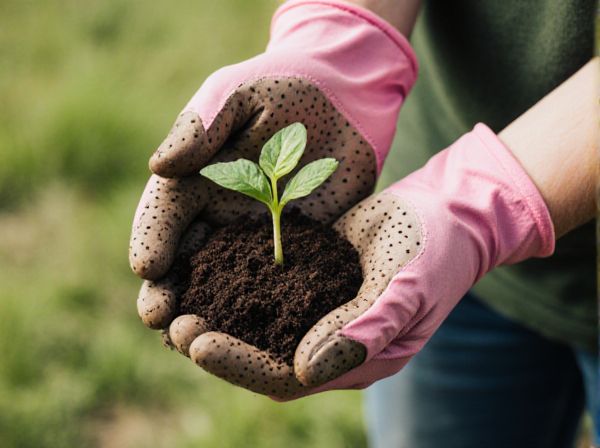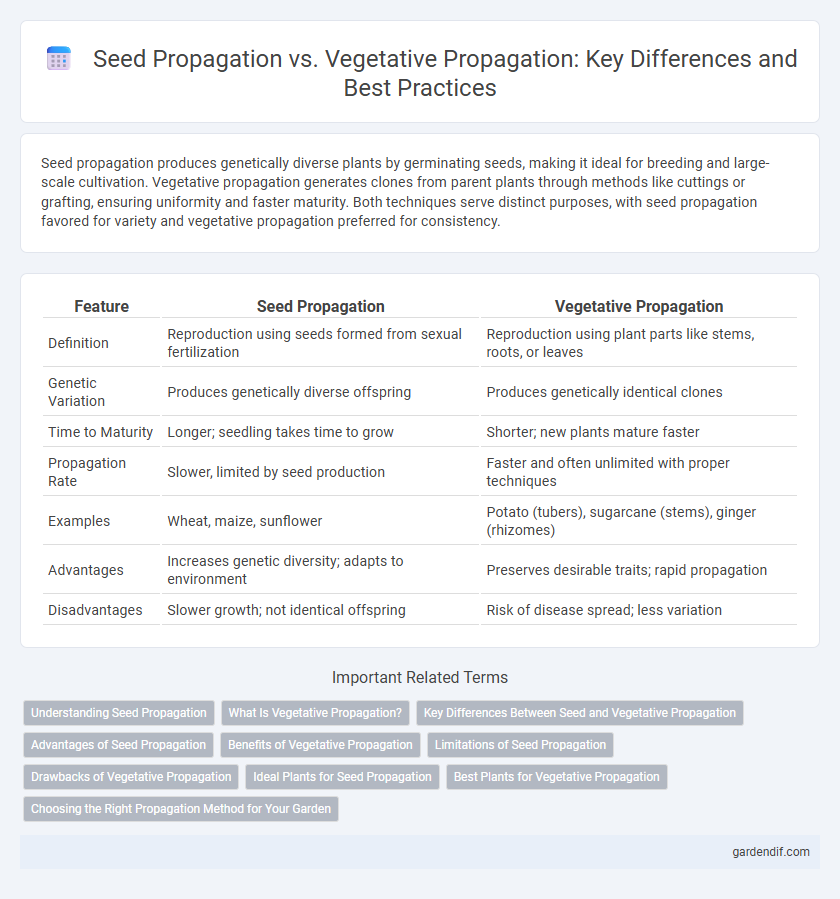
Seed propagation vs Vegetative propagation Illustration
Seed propagation produces genetically diverse plants by germinating seeds, making it ideal for breeding and large-scale cultivation. Vegetative propagation generates clones from parent plants through methods like cuttings or grafting, ensuring uniformity and faster maturity. Both techniques serve distinct purposes, with seed propagation favored for variety and vegetative propagation preferred for consistency.
Table of Comparison
| Feature | Seed Propagation | Vegetative Propagation |
|---|---|---|
| Definition | Reproduction using seeds formed from sexual fertilization | Reproduction using plant parts like stems, roots, or leaves |
| Genetic Variation | Produces genetically diverse offspring | Produces genetically identical clones |
| Time to Maturity | Longer; seedling takes time to grow | Shorter; new plants mature faster |
| Propagation Rate | Slower, limited by seed production | Faster and often unlimited with proper techniques |
| Examples | Wheat, maize, sunflower | Potato (tubers), sugarcane (stems), ginger (rhizomes) |
| Advantages | Increases genetic diversity; adapts to environment | Preserves desirable traits; rapid propagation |
| Disadvantages | Slower growth; not identical offspring | Risk of disease spread; less variation |
Understanding Seed Propagation
Seed propagation involves the growth of new plants from seeds, harnessing genetic diversity to produce resilient and adaptable offspring suitable for various environments. This method relies on sexual reproduction, where fertilization combines genetic material from two parent plants, enabling natural selection and evolution in plant populations. Seed propagation is widely used in agriculture and horticulture for crop improvement, breeding, and large-scale plant production.
What Is Vegetative Propagation?
Vegetative propagation is a form of asexual reproduction in plants where new individuals develop from the vegetative parts such as stems, roots, or leaves, bypassing seed formation. This method ensures genetic uniformity and allows rapid multiplication of desirable plant varieties, commonly used in horticulture and agriculture. Unlike seed propagation, vegetative propagation produces clones of the parent plant, preserving traits like disease resistance and fruit quality.
Key Differences Between Seed and Vegetative Propagation
Seed propagation utilizes sexual reproduction, generating genetic diversity through seeds formed by fertilization, while vegetative propagation relies on asexual methods producing clones identical to the parent plant. Seed propagation generally requires more time for germination and growth to maturity, whereas vegetative propagation offers faster establishment and uniformity, crucial for commercial crop production. Additionally, seed propagation enhances adaptability and resilience in plants, but vegetative propagation ensures the preservation of specific desirable traits without genetic variation.
Advantages of Seed Propagation
Seed propagation offers genetic diversity, which enhances plant adaptability and resilience to environmental stressors. It allows for large-scale production of plants at a relatively low cost, making it ideal for commercial agriculture and reforestation projects. Seeds also have a longer storage life compared to vegetative parts, enabling easier transportation and preservation for future planting.
Benefits of Vegetative Propagation
Vegetative propagation offers rapid plant multiplication with genetic consistency, ensuring uniform crop quality and traits. This method bypasses seed dormancy and germination variability, resulting in faster maturity and higher survival rates. It is especially beneficial for reproducing plants that do not produce viable seeds or have complex hybrid genetics.
Limitations of Seed Propagation
Seed propagation faces limitations such as genetic variability, leading to inconsistent plant traits and quality. Germination rates can be unpredictable due to seed dormancy or poor viability, affecting crop uniformity and yield. Some plants produce seeds that require specific environmental conditions or long periods to germinate, restricting efficient and rapid propagation.
Drawbacks of Vegetative Propagation
Vegetative propagation often leads to reduced genetic diversity, increasing vulnerability to diseases and environmental changes. It can also result in the accumulation of pathogens over successive generations, compromising plant health. Moreover, some vegetative methods require specialized skills and equipment, limiting accessibility for large-scale or amateur propagation.
Ideal Plants for Seed Propagation
Ideal plants for seed propagation typically include annuals, biennials, and many herbaceous perennials due to their ability to produce viable seeds with high germination rates. Seed propagation is especially effective for plants like tomatoes, marigolds, and beans that benefit from genetic diversity and disease resistance inherent in seed-grown offspring. This method accelerates breeding programs and allows large-scale production of uniform, healthy seedlings suitable for commercial and home gardening.
Best Plants for Vegetative Propagation
Vegetative propagation excels in plants like strawberries, potatoes, and spider plants, which naturally produce runners, tubers, or plantlets ideal for cloning. Unlike seed propagation, vegetative methods ensure genetic uniformity and faster maturity, crucial for commercial horticulture and home gardening. These plants demonstrate high success rates in propagation from cuttings, division, and layering, making them top choices for reliable and efficient reproduction.
Choosing the Right Propagation Method for Your Garden
Seed propagation promotes genetic diversity and is ideal for growing many types of flowering plants, vegetables, and trees, especially when introducing new varieties. Vegetative propagation, including methods like cuttings, layering, and grafting, ensures uniformity and faster growth, making it suitable for fruit trees, shrubs, and plants that do not produce viable seeds. Selecting the right propagation method depends on the plant species, desired genetic traits, growth speed, and the gardener's skill level to achieve optimal garden development.
Seed propagation vs Vegetative propagation Infographic

 gardendif.com
gardendif.com